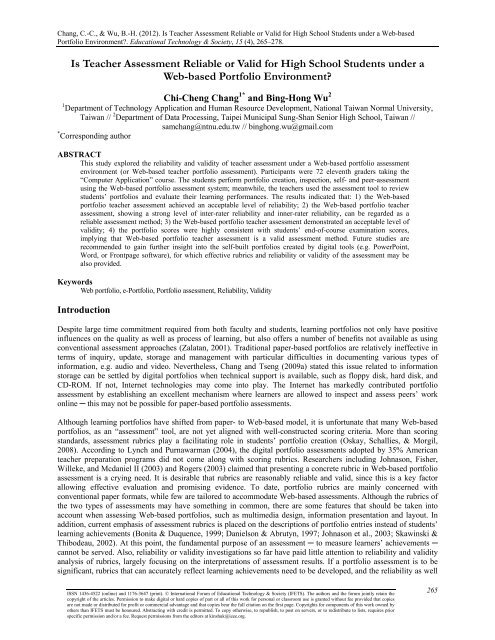October 2012 Volume 15 Number 4 - Educational Technology ...
October 2012 Volume 15 Number 4 - Educational Technology ...
October 2012 Volume 15 Number 4 - Educational Technology ...
You also want an ePaper? Increase the reach of your titles
YUMPU automatically turns print PDFs into web optimized ePapers that Google loves.
Chang, C.-C., & Wu, B.-H. (<strong>2012</strong>). Is Teacher Assessment Reliable or Valid for High School Students under a Web-based<br />
Portfolio Environment?. <strong>Educational</strong> <strong>Technology</strong> & Society, <strong>15</strong> (4), 265–278.<br />
Is Teacher Assessment Reliable or Valid for High School Students under a<br />
Web-based Portfolio Environment?<br />
Chi-Cheng Chang 1* and Bing-Hong Wu 2<br />
1 Department of <strong>Technology</strong> Application and Human Resource Development, National Taiwan Normal University,<br />
Taiwan // 2 Department of Data Processing, Taipei Municipal Sung-Shan Senior High School, Taiwan //<br />
samchang@ntnu.edu.tw // binghong.wu@gmail.com<br />
* Corresponding author<br />
ABSTRACT<br />
This study explored the reliability and validity of teacher assessment under a Web-based portfolio assessment<br />
environment (or Web-based teacher portfolio assessment). Participants were 72 eleventh graders taking the<br />
“Computer Application” course. The students perform portfolio creation, inspection, self- and peer-assessment<br />
using the Web-based portfolio assessment system; meanwhile, the teachers used the assessment tool to review<br />
students’ portfolios and evaluate their learning performances. The results indicated that: 1) the Web-based<br />
portfolio teacher assessment achieved an acceptable level of reliability; 2) the Web-based portfolio teacher<br />
assessment, showing a strong level of inter-rater reliability and inner-rater reliability, can be regarded as a<br />
reliable assessment method; 3) the Web-based portfolio teacher assessment demonstrated an acceptable level of<br />
validity; 4) the portfolio scores were highly consistent with students’ end-of-course examination scores,<br />
implying that Web-based portfolio teacher assessment is a valid assessment method. Future studies are<br />
recommended to gain further insight into the self-built portfolios created by digital tools (e.g. PowerPoint,<br />
Word, or Frontpage software), for which effective rubrics and reliability or validity of the assessment may be<br />
also provided.<br />
Keywords<br />
Web portfolio, e-Portfolio, Portfolio assessment, Reliability, Validity<br />
Introduction<br />
Despite large time commitment required from both faculty and students, learning portfolios not only have positive<br />
influences on the quality as well as process of learning, but also offers a number of benefits not available as using<br />
conventional assessment approaches (Zalatan, 2001). Traditional paper-based portfolios are relatively ineffective in<br />
terms of inquiry, update, storage and management with particular difficulties in documenting various types of<br />
information, e.g. audio and video. Nevertheless, Chang and Tseng (2009a) stated this issue related to information<br />
storage can be settled by digital portfolios when technical support is available, such as floppy disk, hard disk, and<br />
CD-ROM. If not, Internet technologies may come into play. The Internet has markedly contributed portfolio<br />
assessment by establishing an excellent mechanism where learners are allowed to inspect and assess peers’ work<br />
online ─ this may not be possible for paper-based portfolio assessments.<br />
Although learning portfolios have shifted from paper- to Web-based model, it is unfortunate that many Web-based<br />
portfolios, as an “assessment” tool, are not yet aligned with well-constructed scoring criteria. More than scoring<br />
standards, assessment rubrics play a facilitating role in students’ portfolio creation (Oskay, Schallies, & Morgil,<br />
2008). According to Lynch and Purnawarman (2004), the digital portfolio assessments adopted by 35% American<br />
teacher preparation programs did not come along with scoring rubrics. Researchers including Johnason, Fisher,<br />
Willeke, and Mcdaniel II (2003) and Rogers (2003) claimed that presenting a concrete rubric in Web-based portfolio<br />
assessment is a crying need. It is desirable that rubrics are reasonably reliable and valid, since this is a key factor<br />
allowing effective evaluation and promising evidence. To date, portfolio rubrics are mainly concerned with<br />
conventional paper formats, while few are tailored to accommodate Web-based assessments. Although the rubrics of<br />
the two types of assessments may have something in common, there are some features that should be taken into<br />
account when assessing Web-based portfolios, such as multimedia design, information presentation and layout. In<br />
addition, current emphasis of assessment rubrics is placed on the descriptions of portfolio entries instead of students’<br />
learning achievements (Bonita & Duquence, 1999; Danielson & Abrutyn, 1997; Johnason et al., 2003; Skawinski &<br />
Thibodeau, 2002). At this point, the fundamental purpose of an assessment ─ to measure learners’ achievements ─<br />
cannot be served. Also, reliability or validity investigations so far have paid little attention to reliability and validity<br />
analysis of rubrics, largely focusing on the interpretations of assessment results. If a portfolio assessment is to be<br />
significant, rubrics that can accurately reflect learning achievements need to be developed, and the reliability as well<br />
ISSN 1436-4522 (online) and 1176-3647 (print). © International Forum of <strong>Educational</strong> <strong>Technology</strong> & Society (IFETS). The authors and the forum jointly retain the<br />
copyright of the articles. Permission to make digital or hard copies of part or all of this work for personal or classroom use is granted without fee provided that copies<br />
are not made or distributed for profit or commercial advantage and that copies bear the full citation on the first page. Copyrights for components of this work owned by<br />
others than IFETS must be honoured. Abstracting with credit is permitted. To copy otherwise, to republish, to post on servers, or to redistribute to lists, requires prior<br />
specific permission and/or a fee. Request permissions from the editors at kinshuk@ieee.org.<br />
265

















